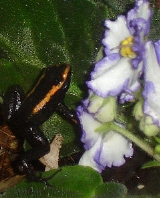
Phyllobates aurotaenia
Encyclopedia
The Kokoe Poison Dart Frog (Phyllobates aurotaenia) is the smallest of the three most-toxic members of the genus Phyllobates
. While it is small, it is just as toxic as Phyllobates bicolor when encountered in the wild. This is one of the more audible of the Poison dart frog
s and has a call often described as beautiful and bird-like. The young frogs of the Phyllobates genus resemble this species, possessing black body with a green, orange, or gold U-shaped pattern starting at the snout. The two larger species' colors fill in the black, leaving a mostly solid colored frog while many P. aurotaenia retain this pattern into adulthood as well as small sky blue speckles on the black areas of the body. This species is found in the Atrato
and San Juan drainages of Colombia
. As a vivarium subject, this frog is an active animal that will make use of vertical space. Kokoe dart frogs are highly social frogs that require high humidity, cool temperatures, and larger prey items than many dart frogs. They do not engage in wrestling behavior among each other like many other dart frogs. Males vying for a female will face off calling loudly until one will backs down. Unlike the other Phyllobates, these frogs will not breed in coconut shells; they prefer to lay their eggs inside a narrow tube (small film canisters, nut pods) on the ground. Kokoe dart frogs have 15–28 eggs at a time. They are found in green, red, narrow-banded orange or gold, and wide-banded orange or gold forms.
through its permeable skin. This poison is a highly potent neurotoxic
alkaloid
poison, which functions like an acid, by seeping through open wounds, and, it is believed, through the pores. In humans, this causes a variety of symptoms including excruciating pain, fever, and seizures. Later, paralysis occurs. While not as toxic as its larger relatives, the Neari Poison Frog and Golden Poison Frog, the Kokoe Poison Frog is still extremely poisonous. Fatalities caused by the frog are suspected, but currently cannot be confirmed.
Phyllobates
Phyllobates is a genus of poison dart frogs native to South America, from Nicaragua to Colombia. Phyllobates contains the most poisonous species of frog, the Golden Poison Frog . They are typical of the poison dart frogs, in that all species are colourful, and have varying degrees of toxicity...
. While it is small, it is just as toxic as Phyllobates bicolor when encountered in the wild. This is one of the more audible of the Poison dart frog
Poison dart frog
Poison dart frog is the common name of a group of frogs in the family Dendrobatidae which are native to Central and South America. These species are diurnal and often have brightly-colored bodies...
s and has a call often described as beautiful and bird-like. The young frogs of the Phyllobates genus resemble this species, possessing black body with a green, orange, or gold U-shaped pattern starting at the snout. The two larger species' colors fill in the black, leaving a mostly solid colored frog while many P. aurotaenia retain this pattern into adulthood as well as small sky blue speckles on the black areas of the body. This species is found in the Atrato
Atrato
Atrato is a municipality and town in the Chocó Department near the Pacific Ocean, Colombia.-References:...
and San Juan drainages of Colombia
Colombia
Colombia, officially the Republic of Colombia , is a unitary constitutional republic comprising thirty-two departments. The country is located in northwestern South America, bordered to the east by Venezuela and Brazil; to the south by Ecuador and Peru; to the north by the Caribbean Sea; to the...
. As a vivarium subject, this frog is an active animal that will make use of vertical space. Kokoe dart frogs are highly social frogs that require high humidity, cool temperatures, and larger prey items than many dart frogs. They do not engage in wrestling behavior among each other like many other dart frogs. Males vying for a female will face off calling loudly until one will backs down. Unlike the other Phyllobates, these frogs will not breed in coconut shells; they prefer to lay their eggs inside a narrow tube (small film canisters, nut pods) on the ground. Kokoe dart frogs have 15–28 eggs at a time. They are found in green, red, narrow-banded orange or gold, and wide-banded orange or gold forms.
Poison
The Kokoe Poison Frog is the third most poisonous of the poison dart frogs. It, like many of the highly poisonous dendrobatids, secretes batrachotoxinsBatrachotoxin
Batrachotoxins are extremely potent cardiotoxic and neurotoxic steroidal alkaloids found in certain species of frogs , melyrid beetles, and birds...
through its permeable skin. This poison is a highly potent neurotoxic
Neurotoxin
A neurotoxin is a toxin that acts specifically on nerve cells , usually by interacting with membrane proteins such as ion channels. Some sources are more general, and define the effect of neurotoxins as occurring at nerve tissue...
alkaloid
Alkaloid
Alkaloids are a group of naturally occurring chemical compounds that contain mostly basic nitrogen atoms. This group also includes some related compounds with neutral and even weakly acidic properties. Also some synthetic compounds of similar structure are attributed to alkaloids...
poison, which functions like an acid, by seeping through open wounds, and, it is believed, through the pores. In humans, this causes a variety of symptoms including excruciating pain, fever, and seizures. Later, paralysis occurs. While not as toxic as its larger relatives, the Neari Poison Frog and Golden Poison Frog, the Kokoe Poison Frog is still extremely poisonous. Fatalities caused by the frog are suspected, but currently cannot be confirmed.

